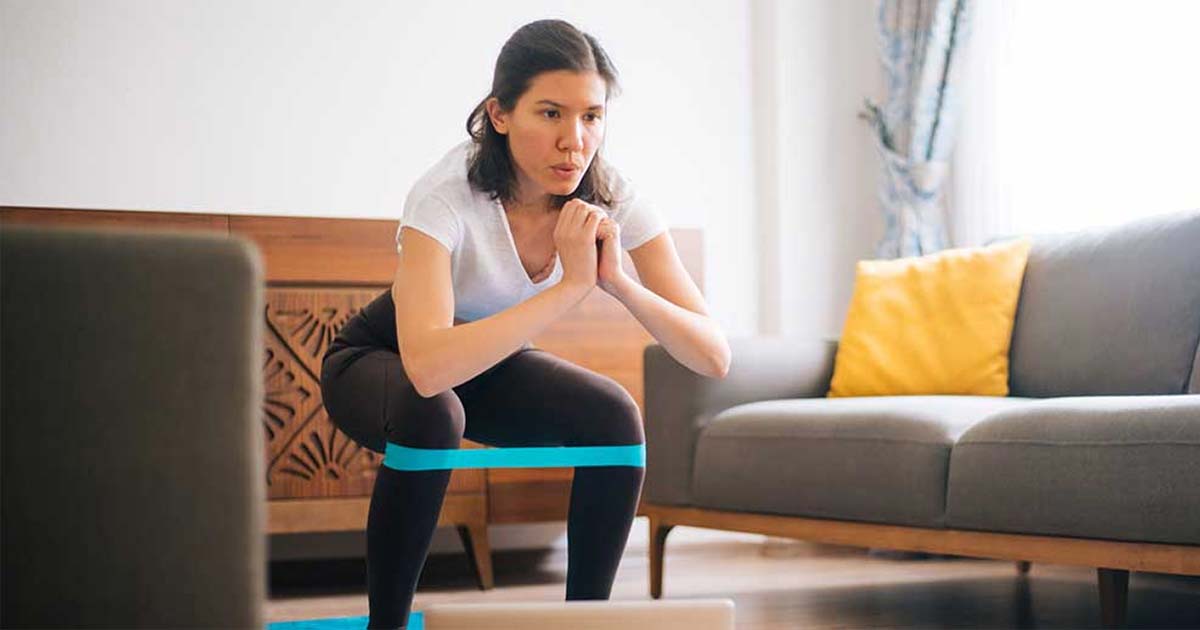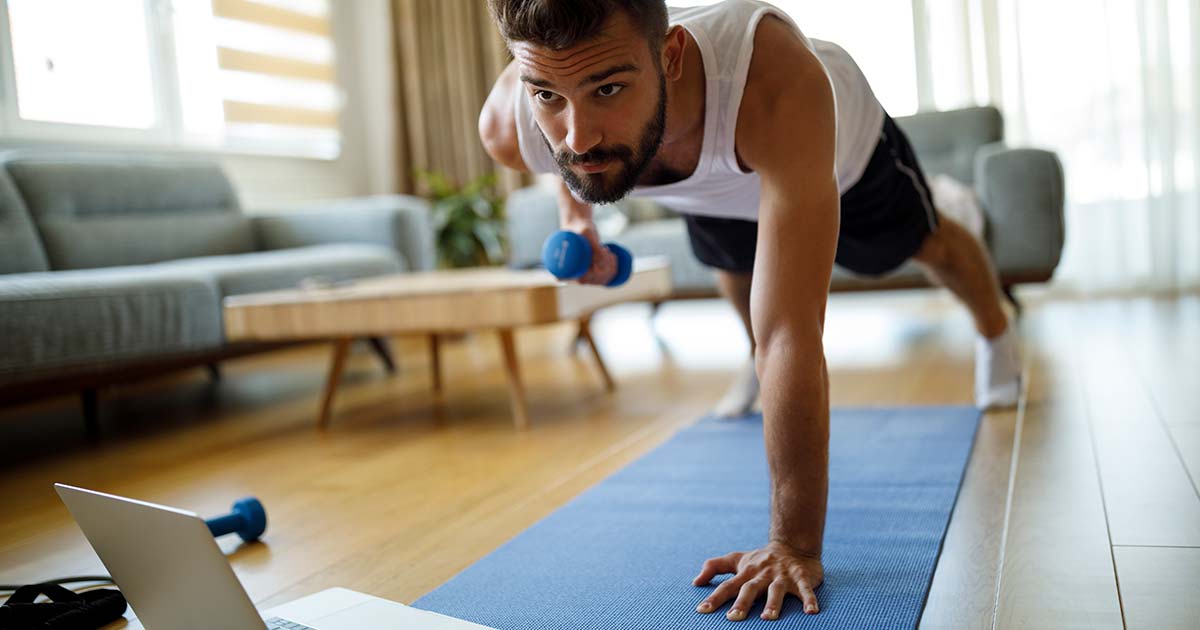Workout Basics: An Exercise Routine Inspired by Your Fifth-Grade Gym Class
Advice to improve your movement, fitness, and overall health from the world's #1 in orthopedics.
Turns out your elementary school gym teachers knew what they were doing. Those gym class exercises you loved (or hated) as a kid were actually working your core, helping your stability and increasing your heart rate. "You might not have known the benefits you were getting from gym class, but most workouts for kids pull from the primary five categories for sports training: movement prep, core stability, lower extremity stability, plyometrics and agility," says Jimmy Russomano, MS, CSCS, manager of education for the Injury Prevention Programs at HSS.

They also form a solid basis for a foundational workout you can do as an adult. Go through this routine to warm up before more rigorous activity or repeat the entire series several times for a total body workout. “After doing all of these exercises, you’ll be a bit sweaty, a little fatigued and your legs could be tired,” says Russomano. “Repeat the exercises or go onto something different. It’s perfect for priming your body and mind and warming up before running, tennis, basketball or another sport.”
Russomano recommends doing each exercise for 30 seconds to one minute based on the amount of time you have. “If you have five minutes, do each exercise for 30 seconds — that’s between five and 10 reps. If you have 10, 15, or 20 minutes, go through the entire workout three times, or spend a little more time on each exercise. The more times you do it, the more challenging it will be.”
Movement prep: Jumping jacks and knee hugs
Kickstart your workout with full-body movements to get your heart rate up, but don’t go all out right away. “These exercises get your heart pumping and build a little bit of flexibility,” says Russomano. “Beginning nice and slow sets a healthy pace for your workout, so you don’t burn out too quickly.”
For your jumping jacks, you should land in a slightly wider than shoulder-width stance as you jump out. Knee hugs are exactly what they sound like: Lift one knee at a time up toward your torso, hold it there briefly with both hands, then release and switch sides.
Core stability: Cat/cow and plank position
Strengthening your core helps you avoid back injuries, among other benefits. “Your core controls the position of your pelvis,” says Russomano. “When your pelvis is in a neutral position, there’s less stress on your back.”
Cat/Cow
- Get onto your hands and knees with your hands under your shoulders, knees under your hips and your back parallel to the ground. (This is your neutral position.)
- Arch your back by tightening your abdominal muscles, squeezing your buttocks and rotating your tailbone backward (“cat”).
- Hold this position for 3 seconds.
- Let your belly button sag toward the floor, rotate your tailbone forward and stretch the front of your neck (“cow”).
- Hold this position for 3 seconds.
- Return to the neutral position and repeat 5 to 10 times.
Plank position:
- Get into a forearm plank position with your elbows positioned directly below your shoulders and feet hip-width apart. Only your toes and forearms should be on the floor.
- Hold this position for 30 seconds to one minute, then lower down.
Tip: Keep your body correctly aligned throughout the exercise. “Don’t crank your neck up to look forward or down at your toes,” says Russomano. “Look at a spot directly between your forearms.”
Lower extremity stability: Progressive squats and heel raises
Improved balance and stability help reduce the likelihood of injury and improve all your movement. These bodyweight exercises strengthen the fronts and backs of your thighs, buttocks, hip flexors, and calves as well as improve balance.
Progressive squats:
- Stand with your feet shoulder-width apart.
- Push your hips backward while keeping your spine straight until your knees are bent, lowering to approximately 25 percent of a full squat (quarter squat). Rise back to standing. Repeat 4 to 5 times.
- Continue the movement, lowering to a squat approximately 50 percent deeper. Rise back to standing. Repeat 4 to 5 times.
- Continue the movement, lowering to a deeper (full) squat in which your thighs are parallel to the floor. Rise back to standing. Repeat 4 to 5 times, for 12 to 15 total repetitions.
Tip: Focus on your form rather than how deep you lower down. “Like your gym class teacher told you, technique is the most important thing,” says Russomano. “It’s not about getting as deep as you can, it’s about getting as deep as you can without compromising form.”
Double-leg heel raises:
- Stand facing a wall with feet parallel and hip-width apart and a hand or hands on the wall for support.
- Lift your heels from the floor to push up onto the balls of your feet.
- Slowly lower yourself back down.
- Repeat 10 to 15 times.
Plyometrics: Vertical jumps
Plyometrics are exercises in which you exert maximum effort for short bursts. They get your heart rate up and help you build power. “Exercising at different intensities works out your heart at different rates and makes all the activities you do all that more enjoyable,” says Russomano. These exercises are tiring, so plan for 30 seconds or more of intense work. “You’ll be pretty exhausted, no matter how much you exercise,” says Russomano. “If you go for a minute, you’ll be cooked at 45 seconds in.”
Progressive squat-to-jumps:
These combine progressive squats and heel raises and add vertical jumps.
- Stand with your feet shoulder-width apart.
- Lower yourself down into a full squat. Rise through standing to a double-leg heel raise. Repeat 2 to 3 times.
- Continue to lower yourself down but rise with a vertical jump at approximately a 25 percent effort. (You should get some air under your feet, but don’t yet aim for the ceiling.) Land with your knees bent in a squat position. Repeat 2 to 3 times.
- Continue the movement, increasing your jump effort to 100 percent.
- Repeat with 30 seconds to one minute between each.
Tip: As with the squats, focus on the correct technique, controlling your movement and landing in an athletic stance. “Land with your knees over your shoelaces and make sure that your knees aren’t rotating inward during takeoff or landing, and that your feet are quiet when you land” says Russomano.
Agility: Chop and stop with vertical jump
Agility, the ability to change speed and direction while running, is critical for most sports. “You can’t change direction safely if you can’t change speed first,” says Russomano.
Stop and chops:
For this exercise, “chop” your feet at your destination by quickly moving into an athletic stance, feet slightly wider than hip-width apart.
- Find a spot on the floor between three and four yards in front of you.
- Run quickly toward the spot. As you get closer to it, slowly begin to chop your feet while gradually pushing your hips backward. When you get to the spot, you should be frozen in a half squat position.
- Walk back to your starting point.
- Repeat for 30 seconds to one minute.
Stop, chop and vertical jumps:
- Find a spot on the floor between four and five yards in front of you.
- Run quickly toward the spot. As you get closer to it, slowly begin to chop your feet while gradually pushing your hips backward. When you get to the spot, you should be frozen in a half squat position.
- Jump as high as you can, landing back in an athletic stance.
- Pause, then walk back to your starting point.
- Repeat for 30 seconds to one minute.
Tip: “Stick your landing after the jump,” says Russomano. “Make sure you’re completely in control.”




